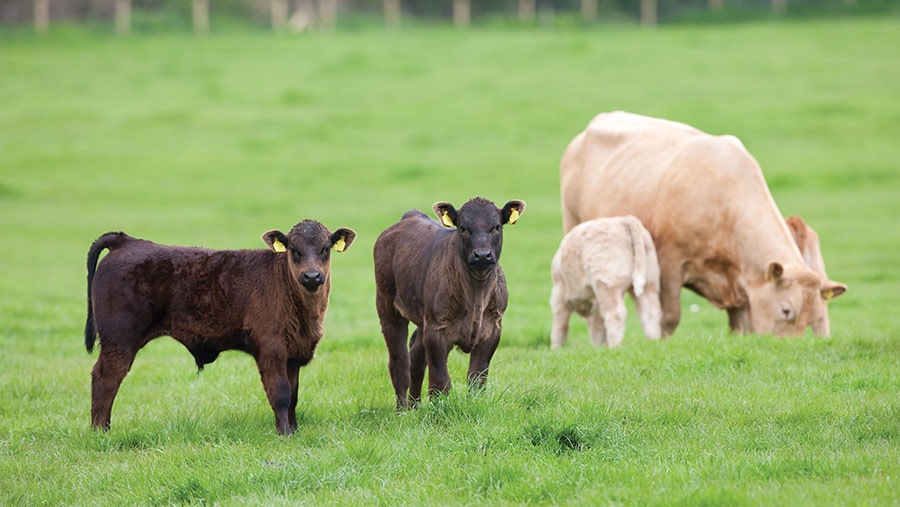4 key pointers from a beef grazing trial
 © Tim Scrivener
© Tim Scrivener Rotational grazing can help lift suckler beef gross margins by £234/ha, a five-year farm project has revealed.
Four English beef farmers took part in the AHDB-funded trial, which began in October 2015.
On average, gross margins (GM) increased from £419/ha in 2015 to £653/ha in 2018, with the highest GM of £778/ha achieved in 2017.
Farms are expected to hit a target of £1,000/ha GM once the 2019 data has been collected.
See also: 9-step guide to setting up a beef grazing rotation
The drought of 2018 impacted grass growth and cattle growth rates, meaning three of the four farms that dried up were forced to purchase straw, silage and concentrates, lowering margins.
The aim of the trial was to increase profitability per hectare by:
- Increasing stocking rates on the grazing platform
- Increasing cattle growth rates from grass and silage
- Reducing the number of days cattle were housed.
About the trial
Soil samples were taken on the four participating farms and deficiencies were addressed.
Grazing platforms were established by taking advantage of existing water troughs, with electric fences used to create 1ha paddocks.
Much of the grazing platforms used were permanent pasture, wet or steep ground that wasn’t practical for silage production. Cattle were moved every two to three days in bulling groups of 33-40.
Adas consultant Marc Jones and grassland consultant Charlie Morgan of GrassMaster oversaw the trial, providing technical support and advice for the farmers.
Below, Mr Jones explains the outcomes and learnings of the project.
1. Grazing can improve liveweight gains but it must be managed well
Kilos produced per hectare from grass improved by 353% on average over a four-year period on the farms.
How farms improved output |
|
|
Year |
Kilos produced per hectare |
|
2015 |
110 |
|
2016 |
262 |
|
2017 |
323 |
|
2018 |
388 |
This was achieved by increasing the stocking rates and managing grass much better. Stocking rates increased 60% from 0.8 livestock unit (LU)/ha to 1.5LU/ha.
Daily liveweight gains improved from 1.07kg to 1.15kg a head a day from 2015 to 2018.
Learnings
- Suckler cows can be used to graze poorer pasture
- Rotational grazing can help increase the proportion of sown species (ryegrass/clover) and reduce weed burdens because cows are forced to eat some of it
- When calves were suckling cows, it didn’t matter if the cows were grazing poorer-quality grass because they still did a good job of converting the grass into milk
- Grass quality in the second grazing season (when store cattle were weaned) was vital
- Having clover in swards made a big difference to weight gains
- Measuring grass helps with planning and feed budgeting – you can see shortages coming two to three weeks before they happen
- But measuring grass isn’t a must: Farmers on the trial didn’t measure using a plate meter as the project progressed. Instead, they opted to judge covers “by eye” and they still got good results
- Be flexible: Have extra paddocks in case you run short of grass (these can be cut for silage if not used) and don’t be afraid to house the cattle if grazing conditions are poor.
2. Don’t underestimate the importance of good silage quality
Before the trial, youngstock realised 0.3-0.4kg/day over the winter period because of poor-quality silage.
Farmers improved silage quality to 11-12ME by applying more nitrogen and cutting earlier instead of leaving it eight to 10 weeks to get a bulkier crop. This saw winter liveweight gains double to 0.7kg/day.
Adding concentrate to store cattle rations saw this lift to more than 1kg/day with very little additional cost.
Learnings
- Cut grass at the five to six-week growth phase to achieve 11ME and 12ME
- Ensure you are applying enough nitrogen
- Use fertiliser with sulphur to improve protein and yields.
3. Managing grass well in a rotational grazing system can help reduce housing costs
On average, the farmers saved five weeks worth of housing costs by extending the grazing season.
Housing typically costs £1.80/day per cow. Based on a 50% cost reduction, this would save a 100-cow suckler herd £27 a cow a month or £2,700/year.
Learnings
- Get fertiliser on early – ideally, 30kg/ha of nitrogen in February
- Apply a late fertiliser application in the first two weeks of September to boost growth going into winter
- Start your last rotation on 1 October
- Rest grass over the winter to ensure sufficient covers – do not graze sheep on fields designated for cattle in the spring. They will wipe out covers and this will delay grazing until the following April/May.
4. Outwintering on forage crops can reduce costs
During the winter, two farms on lighter soils practised outwintering using fodder beet. Fodder beet yields were 25t/ha of DM on average with an energy content of 12-12.5ME.
Youngstock on these farms achieved daily liveweight gains of 0.8kg a head a day on average. Not only did the outwintering systems reduce housing costs, but they also introduced organic matter to arable fields.
Learnings
- Choose your site carefully: don’t select steep fields or ones next to watercourses
- Maintain a 10-15m buffer strip of long grass around the field to reduce run-off
- Run-backs on to permanent pasture don’t work as cattle poach fields
- Instead, house cattle or move them to yards if conditions deteriorate
- Create lying areas using straw pads
- Don’t roll out silage – cattle will waste 60% of it. Use ring feeders.
